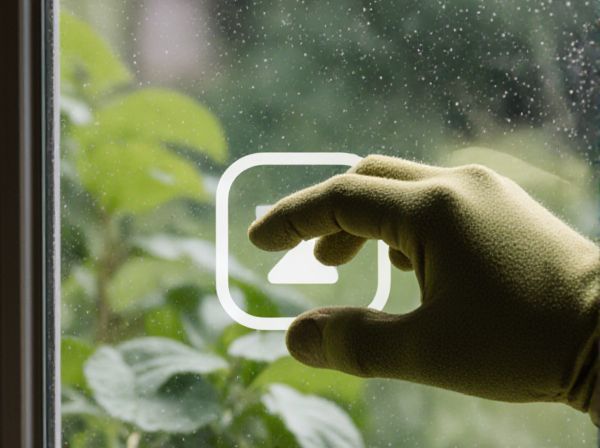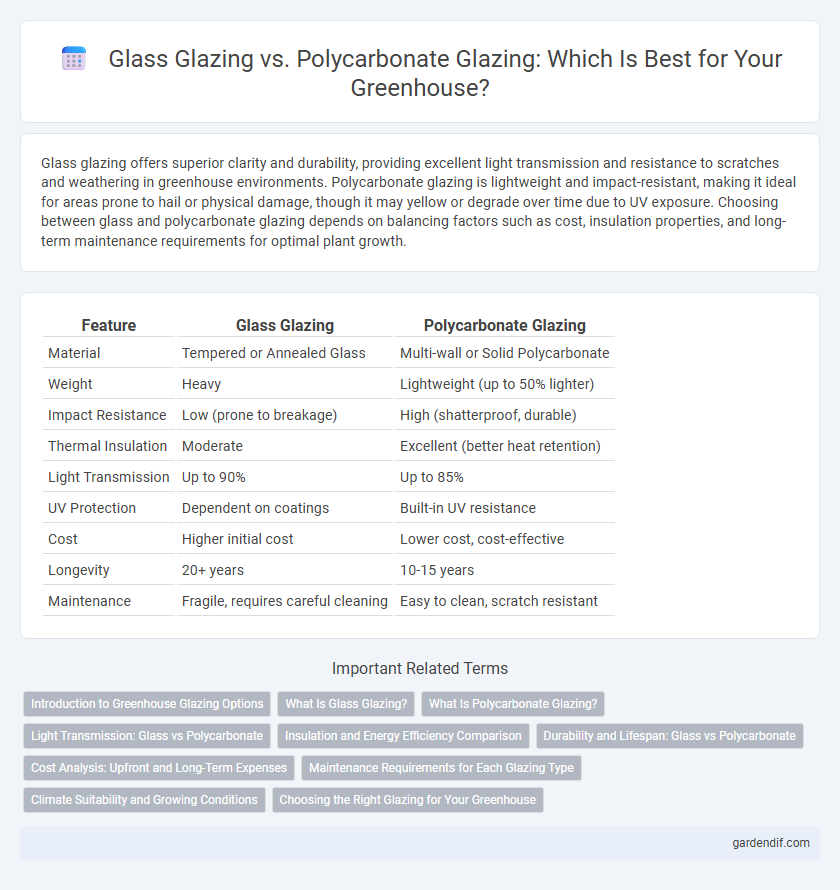
Glass Glazing vs Polycarbonate Glazing Illustration
Glass glazing offers superior clarity and durability, providing excellent light transmission and resistance to scratches and weathering in greenhouse environments. Polycarbonate glazing is lightweight and impact-resistant, making it ideal for areas prone to hail or physical damage, though it may yellow or degrade over time due to UV exposure. Choosing between glass and polycarbonate glazing depends on balancing factors such as cost, insulation properties, and long-term maintenance requirements for optimal plant growth.
Table of Comparison
| Feature | Glass Glazing | Polycarbonate Glazing |
|---|---|---|
| Material | Tempered or Annealed Glass | Multi-wall or Solid Polycarbonate |
| Weight | Heavy | Lightweight (up to 50% lighter) |
| Impact Resistance | Low (prone to breakage) | High (shatterproof, durable) |
| Thermal Insulation | Moderate | Excellent (better heat retention) |
| Light Transmission | Up to 90% | Up to 85% |
| UV Protection | Dependent on coatings | Built-in UV resistance |
| Cost | Higher initial cost | Lower cost, cost-effective |
| Longevity | 20+ years | 10-15 years |
| Maintenance | Fragile, requires careful cleaning | Easy to clean, scratch resistant |
Introduction to Greenhouse Glazing Options
Glass glazing offers superior light transmission and durability, making it ideal for high-performance greenhouses requiring maximum sunlight exposure. Polycarbonate glazing provides excellent impact resistance and insulation, reducing heat loss and protecting plants from harsh weather conditions. Both materials cater to different greenhouse needs, balancing cost, energy efficiency, and structural requirements.
What Is Glass Glazing?
Glass glazing is a method of enclosing a greenhouse with transparent glass panels that allow optimal sunlight penetration while providing excellent insulation properties. This glazing type offers superior clarity, durability, and resistance to scratching compared to polycarbonate, making it ideal for maximizing photosynthesis and plant growth. Glass glazing also enhances structural stability and longevity in greenhouse construction, making it a preferred choice for commercial and professional horticulture.
What Is Polycarbonate Glazing?
Polycarbonate glazing is a durable, lightweight alternative to traditional glass used in greenhouse construction, known for its high impact resistance and excellent thermal insulation properties. This glazing material blocks harmful ultraviolet rays while allowing sufficient light transmission essential for plant growth. Its flexibility and shatterproof nature make polycarbonate an ideal choice for harsh climates and energy-efficient greenhouse designs.
Light Transmission: Glass vs Polycarbonate
Glass glazing offers superior light transmission, typically allowing around 90% of natural sunlight to pass through, which is essential for optimal plant growth in greenhouses. Polycarbonate glazing transmits slightly less light, ranging from 80% to 88%, but compensates with higher impact resistance and better insulation properties. Choosing between glass and polycarbonate glazing depends on balancing light requirements with durability and thermal efficiency for greenhouse environments.
Insulation and Energy Efficiency Comparison
Glass glazing offers higher thermal mass, which helps maintain stable interior temperatures but tends to lose heat faster due to lower insulating properties. Polycarbonate glazing provides superior insulation with multi-wall construction, reducing heat transfer and improving energy efficiency in greenhouses. The enhanced insulation of polycarbonate panels lowers heating costs and maintains optimal growing conditions year-round.
Durability and Lifespan: Glass vs Polycarbonate
Glass glazing offers excellent durability with a typical lifespan of 25 to 30 years, providing high resistance to scratches and UV rays but is prone to shattering under impact. Polycarbonate glazing boasts superior impact resistance and can withstand extreme weather conditions, lasting approximately 10 to 20 years, although it may scratch more easily and degrade under prolonged UV exposure if not treated. Choosing between glass and polycarbonate glazing depends on balancing long-term durability with impact resistance and maintenance considerations in greenhouse construction.
Cost Analysis: Upfront and Long-Term Expenses
Glass glazing for greenhouses typically involves higher upfront costs due to the material's price and installation complexity but offers long-term durability and minimal replacement expenses. Polycarbonate glazing presents a lower initial investment with easier installation and better impact resistance, although its lifespan often requires replacement or maintenance costs sooner than glass. Evaluating the total cost of ownership favors glass when long-term durability and minimal upkeep are priorities, while polycarbonate suits budget-conscious projects requiring flexibility and impact resilience.
Maintenance Requirements for Each Glazing Type
Glass glazing in greenhouses demands regular cleaning to prevent dirt buildup and periodic inspection for cracks or breakage, ensuring optimal light transmission and structural integrity. Polycarbonate glazing requires less frequent maintenance due to its impact resistance and UV protection, but still needs occasional cleaning to remove dust and debris and checks for any surface scratches that could affect light diffusion. Both materials benefit from routine maintenance; however, polycarbonate's durability typically reduces long-term upkeep efforts compared to glass.
Climate Suitability and Growing Conditions
Glass glazing offers superior clarity and UV transmission, making it ideal for temperate climates with stable growing conditions where light intensity directly affects plant growth. Polycarbonate glazing provides excellent insulation and impact resistance, better suited for colder or more variable climates as it helps maintain consistent temperatures and protects plants from sudden weather changes. Both materials support optimal plant development, but glass excels in light-dependent growth, while polycarbonate ensures thermal stability and durability.
Choosing the Right Glazing for Your Greenhouse
Glass glazing offers superior clarity and longevity, making it ideal for maximizing sunlight exposure and durability in greenhouses. Polycarbonate glazing provides enhanced impact resistance and better insulation properties, contributing to energy efficiency and protection against weather extremes. Selecting the right glazing depends on factors such as budget, climate conditions, and maintenance preferences to ensure optimal plant growth and greenhouse performance.
Glass Glazing vs Polycarbonate Glazing Infographic

 gardendif.com
gardendif.com